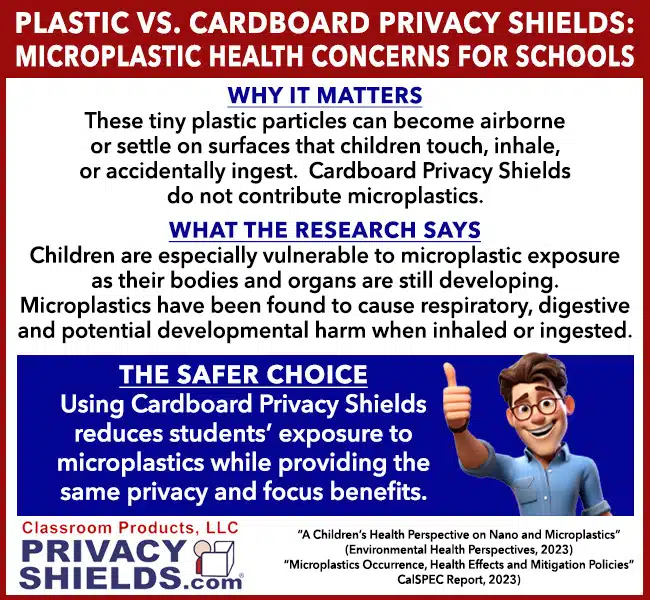
Health Risks of Plastic Privacy Shields and Safe Alternatives
Health Risks of Plastic Privacy Shields and Safe Alternatives
A Comprehensive Report
- Executive Summary
Plastic privacy shields commonly used in educational settings are increasingly scrutinized for their potential health risks due to microplastic particle exposure. Recent research has demonstrated that microplastics accumulate in human tissues, causing numerous adverse health effects. In response, cardboard privacy shields, free from microplastics, represent a safer, practical, and environmentally friendly alternative.
- Introduction to Microplastics
2.1 Definition and Sources
Microplastics are defined as small plastic fragments less than 5 millimeters in diameter, while nanoplastics measure less than 1,000 nanometers. These particles originate from the breakdown of larger plastics or manufactured as microbeads and synthetic fibers. Their presence in everyday environments, including educational facilities, raises substantial public health concerns.
2.2 Routes of Human Exposure
Humans primarily encounter microplastics through ingestion, inhalation, and dermal contact. Microplastics contaminate food and beverages, including bottled and tap water, salt, seafood, and air. They are increasingly detected in indoor environments, especially in enclosed spaces such as classrooms.
- Presence of Microplastics in the Human Body
Microplastics have been identified within various human tissues, including blood, lungs, arterial plaque, placenta, and even brain tissue. This widespread internal contamination signifies a concerning health hazard, particularly for developing children who are most vulnerable to environmental toxins.
- General Health Effects of Microplastic Exposure
4.1 Inflammatory and Oxidative Stress
Microplastics trigger inflammation and oxidative stress at the cellular level. Chronic exposure is associated with increased cellular damage, impaired immune function, and the potential development of chronic diseases.
4.2 Cardiovascular Health Risks
Exposure to microplastics correlates with an elevated risk of cardiovascular diseases. Accumulation in arterial plaques increases the likelihood of severe cardiovascular events, including stroke and heart attacks.
4.3 Respiratory Risks
Inhalation of airborne microplastics can result in respiratory tract inflammation, compromised lung function, and increased susceptibility to respiratory diseases. This is particularly concerning within classroom environments.
4.4 Endocrine and Reproductive Disruption
Microplastics contain endocrine-disrupting chemicals that can interfere with hormonal balance, potentially leading to fertility issues, developmental abnormalities, and metabolic disturbances.
4.5 Neurological and Cognitive Effects
Emerging studies indicate microplastics have the capacity to breach the blood-brain barrier, suggesting potential risks for cognitive impairment, behavioral disorders, and neurological diseases.
4.6 Metabolic Dysfunction and Obesity
Microplastics may alter gut microbiota and metabolism, contributing to insulin resistance, obesity, and associated chronic health conditions.
4.7 Carcinogenic Potential
Long-term exposure to microplastics is suspected to increase cancer risk through chronic inflammation and oxidative cellular damage, highlighting the importance of preventive measures.
- Risks from Plastic Privacy Shields in Classrooms
Rigid plastic privacy shields used in classrooms can degrade and shed microplastic particles, especially with frequent handling and cleaning. Given their proximity to students’ faces, these shields represent a potentially significant source of microplastic inhalation and ingestion in educational settings.
Young students, who have higher vulnerability due to ongoing developmental processes, may experience cumulative and detrimental health impacts through prolonged exposure to microplastics in these educational products.
- Cardboard Privacy Shields: A Safer Alternative
In contrast to plastic shields, cardboard privacy shields are manufactured from recyclable corrugated cardboard without the addition of plastic components. Cardboard shields do not release microplastics and thus represent a safer option.
In addition to their safety benefits, cardboard privacy shields offer:
- Effective visual barriers to enhance student focus and reduce distractions.
- Durable yet lightweight construction.
- Easy storage and recyclability, contributing to sustainable classroom practices.
Adopting cardboard shields can substantially mitigate the microplastic exposure risk in classroom settings, promoting both student health and environmental sustainability.
- Recommendations for Educational Institutions
To address health concerns associated with microplastic exposure from plastic privacy shields, educational institutions are advised to:
- Phase out existing plastic shields and replace them with cardboard alternatives.
- Inform educators, students, and parents of the potential risks of microplastics and benefits of using safer materials.
- Encourage further research and develop guidelines or standards for assessing and mitigating microplastic exposure in educational environments.
- Conclusion
Given the accumulating evidence of microplastic-associated health risks, educational facilities should reconsider the use of plastic-based privacy shields. Transitioning to cardboard privacy shields offers a practical and effective solution for reducing microplastic exposure risks, protecting student health, and enhancing classroom sustainability.
References
- American Association of Medical Colleges (AAMC). Microplastics and Human Health: Risks and Pathways of Exposure.
- Centers for Disease Control and Prevention (CDC). Microplastic Inhalation and Respiratory Health Risks.
- Environmental Working Group (EWG). Health Risks of Microplastic Contamination.
- Forbes Health Report. Microplastics: Hidden Dangers in Everyday Life.
- Harvard School of Public Health. Public Health Concerns from Microplastic Exposure.
- National Institutes of Health (NIH). Microplastic Toxicity in Human Cell Studies.
- Nature Reviews Endocrinology. Endocrine-Disrupting Chemicals in Microplastics.
- Stanford University Medical School. Microplastics Linked to Cardiovascular Disease and Cancer Risks.
- World Health Organization (WHO). Microplastics in Drinking Water: Potential Health Risks.
- Yale School of the Environment. The Impact of Microplastics on Human Health.
- Plastic Pollution Coalition. Sources and Effects of Microplastics in the Environment.
- Journal of Hazardous Materials. Review of Microplastics Toxicity in Human Cells.
- Environmental Pollution Journal. Detection of Microplastics in Human Blood and Organs.
- Microplastics Health Science Coalition. Impact of Microplastic Inhalation on Lung Function.
- Pediatric Health Journal. Environmental Toxins and Developmental Risks in Children.
- Environmental Science & Technology. Microplastic Contamination of Indoor Environments.
- Cell Reports Medicine. Microplastic Accumulation and Inflammation in Human Tissues.
- Cardboard Manufacturing Association. Benefits of Using Cardboard Products in Educational Settings.
- American Academy of Pediatrics. Health Risks of Chemical Exposure in School Environments.
- Science of The Total Environment. Microplastic Shedding from Plastic Materials Used Indoors.








